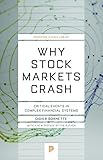Why stock markets crash : critical events in complex financial systems / Didier Sornette ; with a new preface by the author.
By: Sornette, Didier [author.] .
.
Material type:  BookSeries: Princeton science library: Publisher: Princeton, New Jersey : Princeton University Press, 2017Description: 1 online resource (xxvi, 421 pages) : illustrations.Content type: text Media type: computer Carrier type: online resourceISBN: 9781400885091; 1400885094.Subject(s): Stocks -- Prices -- History
BookSeries: Princeton science library: Publisher: Princeton, New Jersey : Princeton University Press, 2017Description: 1 online resource (xxvi, 421 pages) : illustrations.Content type: text Media type: computer Carrier type: online resourceISBN: 9781400885091; 1400885094.Subject(s): Stocks -- Prices -- HistoryIncludes bibliographical references (pages 397-418) and index.
Print version record.
Financial crashes: what, how, why, and when? -- Fundamentals of financial markets -- Financial crashes are "outliers" -- Positive feedbacks -- Modeling financial bubbles and market crashes -- Hierarchies, complex fractal dimensions, and log-periodicity -- Autopsy of major crashes: universal exponents and log-periodicity -- Bubbles, crises, and crashes in emergent markets -- Prediction of bubbles, crashes, and antibubbles -- The end of the growth era?
"The scientific study of complex systems has transformed a wide range of disciplines in recent years, enabling researchers in both the natural and social sciences to model and predict phenomena as diverse as earthquakes, global warming, demographic patterns, financial crises, and the failure of materials. This book applies the author's experience in these areas to propose a simple, powerful, and general theory of how, why, and when stock markets crash. Most attempts to explain market failures seek to pinpoint triggering mechanisms that occur hours, days, or weeks before the collapse. This book proposes a radically different view: the underlying cause can be sought months and even years before the abrupt, catastrophic event in the build-up of cooperative speculation, which often translates into an accelerating rise of stock market prices, otherwise known as a 'bubbles.' The book unearths remarkable insights and some predictions--among them, that the 'end of the growth era' will occur around 2050. The book probes major historical precedents, from the decades-long 'tulip mania' in the Netherlands that wilted suddenly in 1637 to the South Sea Bubble that ended with the first huge market crash in England in 1720, to the Great Crash of October 1929 and Black Monday in 1987, to cite just a few. It concludes that most explanations other than cooperative self-organization fail to account for the subtle bubbles by which the markets lay the groundwork for catastrophe."--Provided by publisher.
In English.
IEEE IEEE Xplore Princeton University Press eBooks Library


There are no comments for this item.